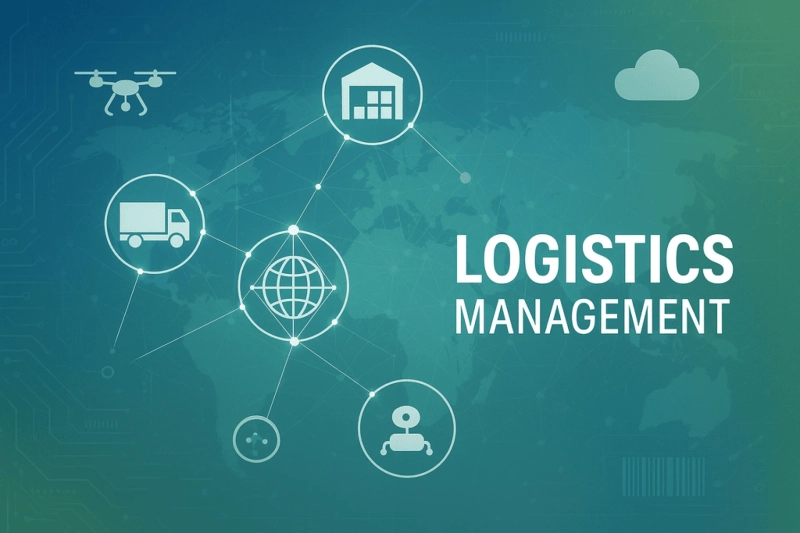Why Automate Inventory and Shipping in 2025?
It was 2010, and I was standing in a dimly lit warehouse in Detroit, watching a team manually enter barcodes into spreadsheets. It was like watching someone try to fuel a jet with a teaspoon—tedious, error-prone, and maddeningly slow.
Fast forward to 2025, and the rules of the game have changed. Today’s logistics environments demand automation—not as a luxury but as a survival imperative. With e-commerce scaling faster than ever and customer expectations reaching breakneck speed, logistics platforms have no room for inefficiencies.
The best logistics management software now integrates automation tools that offer real-time tracking, predictive forecasting, and intelligent route optimization. These aren’t just gadgets—they're power tools for the trade. Let’s walk through the top 7 tools shaping how we automate inventory and shipping in 2025.
What Is Inventory and Shipping Automation?
Inventory and shipping automation is the disciplined use of software systems to manage stock levels, track movement, and handle delivery tasks without constant human intervention. It’s the modern craftsman's way of creating a logistics system that’s both elegant and scalable.
In 2025, leading retailers—from niche e-com brands to giants like Target—are using these systems to automate order fulfillment, minimize delays, and reduce human error.
Why Is Automation Essential for Logistics?
If time is money, automation is a minting machine. It slashes labor costs, eliminates human error, and optimizes throughput across warehouses and distribution hubs.
Amazon’s robotic-driven fulfillment centers are now processing orders within 20 minutes, cutting down last-mile delivery times by over 30% compared to 2020. There is no excuse for lagging behind.
1. Blue Yonder
Once known as JDA Software, Blue Yonder has matured into an AI-driven logistics intelligence platform. It’s not just another logistics tool—it’s a clean process engine built to forecast, adapt, and optimize.
Key Features:
- Predictive inventory forecasting using ML algorithms
- Dynamic route planning with real-time adjustment
- Integrated demand planning for omnichannel retail
Walmart uses Blue Yonder to manage inventory across thousands of locations. That’s not just scale—it’s symphonic coordination in motion.
In 2025, Blue Yonder leverages deep neural networks to detect demand shifts based on everything from weather forecasts to social media sentiment. This is no longer guesswork—it’s calculated precision.
This is craftsmanship in code. And in today’s logistics world, where missed windows mean missed revenue, Blue Yonder delivers the kind of reliability that we, as professionals, must demand.
Used By: Walmart, Coca-Cola
2. LogiNext Mile
Let me tell you a story.
A mid-sized e-commerce startup was losing $20,000 a month in failed deliveries. They had packages in limbo and customers storming support channels. Then they adopted LogiNext Mile, and within 3 months, their delivery success rate jumped by 35%. That’s not just improvement—that’s operational redemption.
What makes LogiNext special?
- Advanced last-mile route optimization
- Real-time driver tracking with geo-fencing
- Auto-allocation of delivery resources
This SaaS-based logistics management system is purpose-built for 2025’s high-velocity shipping landscape. It intelligently adjusts delivery routes based on traffic patterns, weather conditions, and customer availability. It's the GPS for logistics sanity.
Used By: Paytm, Decathlon
3. Zoho Inventory
Guys, not everyone runs a Fortune 500 warehouse. Many of us are dealing with limited budgets, smaller teams, and big ambitions. That’s where Zoho Inventory steps in like a trusted apprentice—reliable, affordable, and capable.
Zoho’s cloud-based platform empowers small and medium businesses to automate:
- Inventory tracking across warehouses
- Multi-channel shipping (Amazon, Shopify, eBay)
- Order fulfillment and delivery status updates
Its integration with over 30 shipping carriers and e-commerce platforms is what turns it from a tool into a full-blown logistics software suite.
One of my favorite features? Automated reordering thresholds. It acts like a silent partner, keeping stock levels from drifting into disaster zones.
Ideal For: Small to mid-sized e-commerce businesses
4. NetSuite
When we talk about enterprise-grade craftsmanship, NetSuite stands tall.
This is an ERP platform that handles everything from inventory and shipping to finance and CRM. For companies like Flexport, NetSuite is the backbone of scalable logistics operations.
Inventory and shipping highlights:
- Multi-location inventory management
- Integrated shipping modules with major carriers
- Real-time stock visibility across global hubs
Its tight integration with warehouse sensors and barcode scanners reduces operational debt caused by manual errors.
NetSuite’s strength is in creating a single source of truth for complex, global operations. If you're running a logistics orchestra, this is your conductor.
Used By: Flexport, Williams-Sonoma
5. Manhattan Active WMS
I’ve always admired systems that scale elegantly. Manhattan Active WMS is a fine example of engineered scalability for growing logistics needs.
This tool is particularly useful for:
- Comparing carrier rates in real-time
- Automatically printing shipping labels
- Scaling across multiple fulfillment centers
It’s a fit for small to medium businesses looking to step up. With a clean UI and flexible modules, it helps teams avoid the operational quicksand of manual processes.
Even better—it works just as well for a local coffee subscription startup as it does for mid-sized retail chains.
Great For: SMEs scaling operations
6. CommuteLogix
Every warehouse is like a living organism—complex, interdependent, and prone to chaos without coordination. CommuteLogix acts like a nervous system for warehouses.
This cloud-based warehouse management system brings clean discipline to inventory and shipping operations.
Its strengths?
- Real-time stock tracking and order accuracy reports
- Intelligent shipping logic based on volume and urgency
- Predictive alerts for delays or bottlenecks
It doesn’t just tell you what went wrong—it shows you how to fix it before things break. That’s what separates real logistics craftsmanship from amateur patchwork.
Ideal For: Fulfillment centers, warehouse ops teams
7. Fishbowl Inventory
Let’s say you're a manufacturer juggling supply chain inputs and outbound shipping. You don’t need 50 features—you need 5 that work flawlessly.
Fishbowl Inventory delivers just that, and its tight integration with QuickBooks makes it a favorite among manufacturers and wholesalers.
Top Features:
- Inventory level tracking
- Pick, pack, and ship automation
- Purchase order and vendor management
In 2025, it’s helping SMB manufacturers streamline shipping without breaking the budget. It's clean, dependable, and disciplined.
Used By: Small to mid-sized manufacturers
Final Thoughts
Friends, if logistics is the engine of commerce, then automation is the oil that keeps it humming.
From Blue Yonder’s predictive intelligence to Fishbowl’s QuickBooks-friendly simplicity, each of these seven tools offers a pathway to cleaner, faster, and more professional logistics operations.
Choose your tools based on your scale, needs, and workflow maturity. Because at the end of the day, it’s our responsibility to build systems that are not just functional—but flawless.
Key Takeaways
- Blue Yonder and LogiNext lead in AI-driven inventory and shipping automation.
- Zoho and Fishbowl offer affordable solutions for small businesses in 2025.
- NetSuite and Manhattan excel for enterprise-scale logistics.
- Fishbowl integrates seamlessly for manufacturers with accounting needs.
- Automation tools enhance efficiency, cost savings, and customer satisfaction.
Frequently Asked Questions (FAQs)
1. What Is Inventory and Shipping Automation?
Inventory and shipping automation refers to the use of software tools to manage stock levels, track shipments, and fulfill orders without manual intervention. It reduces human error, saves time, and allows businesses to scale efficiently while meeting modern e-commerce demands.
2. Why Is Blue Yonder Top-Ranked?
Blue Yonder is top-ranked due to its AI-driven capabilities in forecasting demand and optimizing shipping routes. It’s used by global retailers like Walmart to automate complex supply chains, making it a leader in real-time logistics decision-making in 2025.
3. How Does LogiNext Optimize Shipping?
LogiNext uses AI to automatically assign routes based on delivery location, traffic, and weather conditions. It provides real-time tracking and predictive ETAs, helping businesses reduce fuel costs and missed deliveries while improving customer satisfaction.
4. What Makes Zoho Ideal for SMEs?
Zoho is ideal for small and medium enterprises because it offers affordable, easy-to-use tools for automating inventory and shipping. It integrates with multiple e-commerce channels and shipping providers, giving growing businesses the ability to streamline operations without high overhead.
5. How Do These Tools Improve Efficiency?
These tools automate repetitive and error-prone tasks such as stock tracking, route planning, and shipment labeling. This leads to faster order fulfillment, reduced labor costs, fewer mistakes, and better scalability—critical benefits for any logistics operation in 2025.


